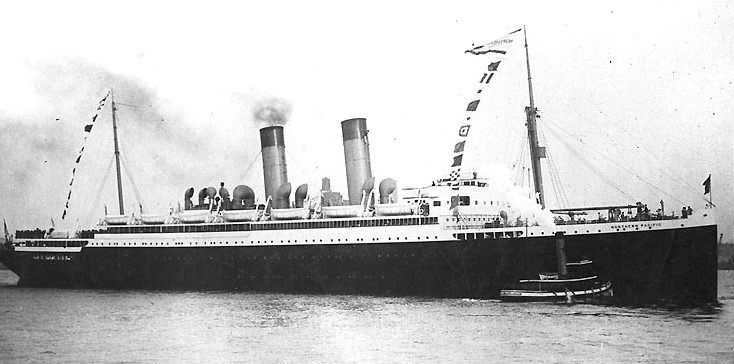
With the War to End All Wars in her wake, the former U.S.S. Northern Pacific, and later U.S.A.T. Northern Pacific, had become too burdensome and expensive for the United States Army to operate and maintain. While she had been one of the fastest troop transports during the war, the United States Army returned the ship to the United States Shipping Board on November 22, 1921 where she was subsequently placed in the New York Reserve Fleet. Within a week, the United States Shipping Board announced that thirty-six various vessels, including twenty-eight cargo vessels, three ocean-going tugboats, four steel oil barges, and one transport were available for bids. The fire-sale had begun and the former S.S. Northern Pacific was on the list.
The S.S. Northern Pacific was designed and ordered by the Great Northern Pacific Steam Ship Company and built by William Cramp & Sons in Philadelphia, Pennsylvania. The passenger ship was designed to accommodate a total of eight hundred and fifty-six passengers and freight for a sea-based linkage between the Great Northern Railway Lines and the Spokane, Portland, and Seattle Railway Terminal located at Astoria, Oregon and at San Francisco, California. She was five hundred and twenty-five feet, eight inches in length with a beam of sixty-three feet, one inch. She was designed as double-hulled vessel with eleven water-tight compartments. The keel was laid on September 23rd, 1913 and the S.S. Northern Pacific was launched October 17, 1914. She left Philadelphia, Pennsylvania on March 25, 1915. Her time in employ was short-lived. The United States Navy needed fast troop transports. The S.S. Northern Pacific and her sister ship, the S.S. Great Northern, were then acquired by the United States Shipping Board. On November 3, 1917, the U.S.S. Northern Pacific was commissioned and renamed the U.S.S. Northern Pacific.

Between November 1917 and August 1919, the U.S.S. Northern Pacific was responsible for transporting troops to and from the European theatre of operations. During her thirteen voyages, she was responsible for transporting over twenty-two thousand service personnel to Europe and returning over nine-thousand to the United States. While her results were overall successful, she grounded off of Fire Island on New Year’s Day 1919 on one return voyage. Despite the unintentional and accidental grounding, the U.S.S. Northern Pacific’s service was herculean in its overall ability to safely transport personnel to and from the war zone. On August 20th, 1919, she was decommissioned and was transferred to the United States Army. Once again, she was renamed with her new moniker, the U.S.A.T. Northern Pacific. After a short utilization by the United States Army, the U.S.A.T. Northern Pacific was returned to the United States Shipping Board in November 1921.
In February of 1922, the U.S.A.T. Northern Pacific was purchased by the Admiral Line. A caveat to the purchase was the reconditioning at the cost of $500,000.00 to be paid by the United States Shipping Board. The plan was to utilize the S.S. Northern Pacific between San Francisco, California and Seattle, Washington and to ports of call in the Far East. In early February 1922, the U.S.A.T. Northern Pacific began her last voyage from Hoboken, New Jersey bound for Chester, Pennsylvania. Under the command of Captain William Lustle, the officers and crew was minimized for the voyage to the shipyard. Instead of the normal compliment of eighteen officers and two hundred and eighty crew, Captain Lustle had only seventy officers and crew aboard. In addition, four draftsmen from the Sun Shipyard, were aboard to work on plans for the intended reconditioning and conversion from troopship to passenger liner.
During the early morning hours of February 8, 1922, a fire broke out aboard the ship. First notification of the emergency was a radio message received at the U.S. Naval Air Station in Cape May, New Jersey. Commander Wilder immediately notified Captain Hustle to launch the U.S.C.G.C. Kickapoo. In the face of a gale and building swells, the cutter raced out of port to render assistance. Meanwhile, as the fire raged throughout the U.S.A.T. Northern Pacific, several vessels transiting nearby, spotted the fire-engulfed vessel and immediately diverted to render aid.
The freighter Transportation, of the Merchants and Miners Line, under the command of Captain Chase, was responsible for removing the bulk of the ship’s compliment amidst the fiery torrent of smoke and flames. The tanker Herbert G. Wylie also arrived on scene and was able, despite the harrowing conditions, to remove two mates, two engineers, and two sailors. The U.S.C.G.C. Kickapoo’s approached the blazing inferno and pulled five of the crew clear from the pyre. As accountability was being completed by Captain Lustle, between the several rescue vessels, it was quickly determined that the four draftsmen from the Sun Shipyard were not aboard any of the ships. It was quickly related by one of the survivors that it was believed that the four draftsmen – W.J. Mallet, T.U. Peckham, R.U. Hall, and H. Kruger – had been trapped below the main deck in their cabins when the fire broke out aboard the ship. Despite efforts by the rescue vessels, all reported zero signs of life on the floating pyre. The fire engulfed ship slowly drifted southeast until she capsized and sank in one hundred and fifty-feet of water, thirty nautical miles south of Cape May, New Jersey. The S.S. Northern Pacific never returned to her intended design and her planned post-war career as a commercial passenger liner. Instead she ended her days on the high seas in a fiery and deadly sinking that occurred in our waters.
Source Listing:
McGann, Thomas. “The Miraculous Rescue of the U.S.S. Northern Pacific,” Article. Fire Island News, June 10, 2019.
The New York Times.
“Transport Ashore Off Fire Island, 3,000 Aboard Safe,” January 2, 1919.
“254 Taken From Transport Before Night Ends Work,” January 3, 1919.
“Navy Boats Land 2,100 More from Northern Pacific,” January 4, 1919.
“Northern Pacific Reaches Harbor,” January 20, 1919.
“Ship Board to Sell the Northern Pacific,” November 30, 1919.
“Ship Burns at Sea, Four Are Missing,” February 9, 1922.
